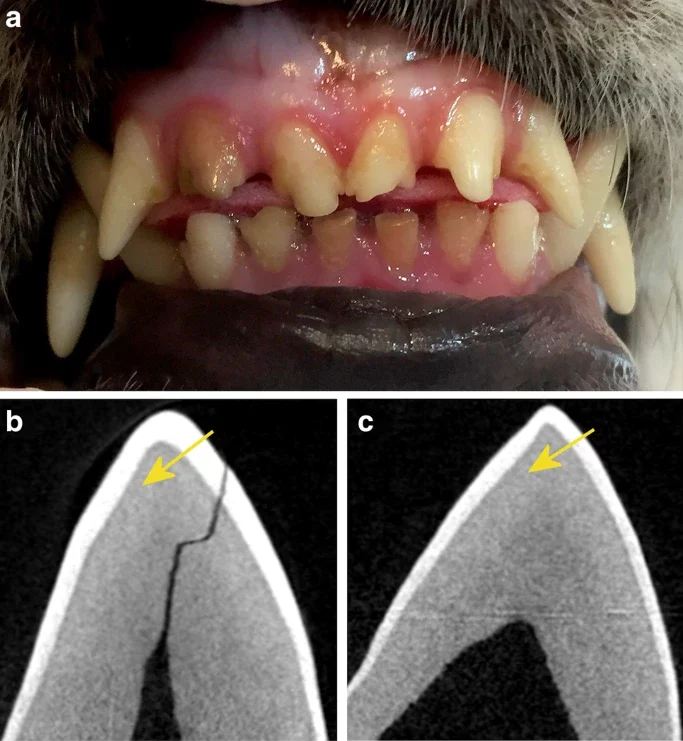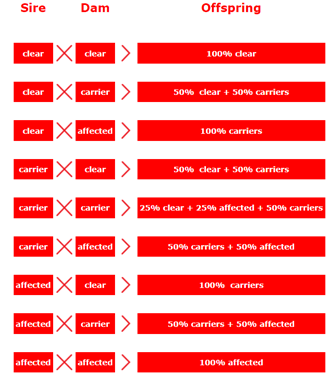What is AI?
AI is a genetic disorder where the enamel covering the dog’s teeth doesn’t develop properly. Because the teeth lack their protective covering they can suffer from a number of problems:
- Wear to the surface of the tooth, this in turn causes:
- Rough, irregular surface with discolouration of the teeth.
- Rough tooth surface allows a build up of bacteria and plaque to form
- Excessive, premature wear of the teeth which causes:
- Gaps to appear between the teeth
- Teeth to become smaller as they are worn away
- Tooth nerve can become exposed and cause pain
- Resulting thin, pointed teeth can be more vulnerable to breakage
Possible loss of some or all of the affected teeth
There is a quick and easy test, just click the link below to get your Akita Inu tested today;
https://www.laboklin.co.uk/laboklin/showGeneticTest.jsp?testID=8303
What Does this mean for me and my dog?
Diagnosis requires x-rays and inspection under a general aesthetic. The teeth then need to be cleaned completely and every tooth coated in a clear seal to protect the dentine from wear, chipping and decay.

The dog will, for the rest of it’s life, require annual checks of the teeth and a repair of any of the seal that has become worn or damaged as necessary.
In order to limit the damage to the coating applied to the teeth care needs to be taken that they don’t knock the teeth. This means limiting chewing on hard bones or objects, not accidentally knocking the teeth when playing with toys or other dogs. Costs for these procedures will vary by region and specialist, but it is likely that most of these treatments will have to be undertaken by a specialist dental vet. The initial treatment costs are likely to be thousands of pounds, the annual treatment can be several hundred to thousands of pounds depending on the treatment needed. This is a significant and ongoing cost to the owner.
How is it inherited?
The inheritance is Autosomal Recessive, this means that one copy of the defective gene has to be inherited from each parent. The dog will only be affected by AI/FEH if it inherits 2 copies of the defective gene, one from each parent.
Clear
Genotype: N / N [ Homozygous normal ]
The dog is noncarrier of the mutant gene.
It is very unlikely that the dog will develop Amelogenesis Imperfecta (AI) / Familial Enamel Hypoplasia (FEH). The dog will never pass the mutation to its offspring, and therefore it can be bred to any other dog.
Carrier
Genotype: N / FEH [ Heterozygous ]
The dog carries one copy of the mutant gene and one copy of the normal gene.
It is very unlikely that the dog will develop Amelogenesis Imperfecta (AI) / Familial Enamel Hypoplasia (FEH) but since it carries the mutant gene, it can pass it on to its offspring with the probability of 50%.
Carriers should only be bred to clear dogs.
Avoid breeding carrier to carrier because 25% of their offspring is expected to be affected (see table)
Affected
Genotype: FEH / FEH [ Homozygous mutant ]
The dog carries two copies of the mutant gene and therefore it will pass the mutant gene to its entire offspring.
The dog is likely to develop Amelogenesis Imperfecta (AI) / Familial Enamel Hypoplasia (FEH) and will pass the mutant gene to its entire offspring

So can I breed from my dog?
As AI is a disease which causes with severe welfare consequences for the dog and significant expense and stress to the owner for the duration of the dog’s lifetime. Because of this it is important to avoid mating’s that can result in affected puppies. Ideally, mating’s to reduce the prevalance of the gene in the population is desirable, although we shouldn’t exclude too many dogs from the gene pool as this may cause
It is recommended that only clear-clear and clear-carrier mating’s are performed.
However, if there is an over-riding reason that an affected dog should be used this should only be to a clear partner and the new owners should be made aware of the puppy’s carrier status
Additional Reading and Downloads
Kennel Club
List of tested dogs in the UK
https://www.thekennelclub.org.uk/media/4321/japanese-akita-inu-ai-feh.pdf
Info and DNA testing from Labokin:
https://www.laboklin.co.uk/laboklin/showGeneticTest.jsp?testID=8303
Testing at Genomia:
https://www.genomia.cz/en/test/ai-acpt/
Canine models of human amelogenesis imperfecta: identification of novel recessive ENAM and ACP4 variants
https://link.springer.com/article/10.1007/s00439-019-01997-8